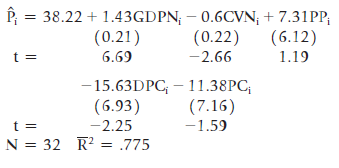Look back at Exercise 9 in Chapter 5, the equation on international price discrimination in pharmaceuticals. In
Question:
Look back at Exercise 9 in Chapter 5, the equation on international price discrimination in pharmaceuticals. In that cross-sectional study, Schut and VanBergeijk estimated two equations in addition to the one cited in the exercise.13 These two equations tested the possibility that CVi, total volume of consumption of pharmaceuticals in the ith country, and Ni, the population of the ith country, belonged in the original equation, Equation 5.15, repeated here:
Where:
Pi = the pharmaceutical price level in the ith country divided by that of the United States
GDPNi = per capita domestic product in the ith country divided by that of the United States
CVNi = per capita volume of consumption of pharmaceuticals in the ith country divided by that of the United States
PPi = a dummy variable equal to 1 if patents for pharmaceutical products are recognized in the ith country, 0 otherwise
DPCi = a dummy variable equal to 1 if the ith country applied strict price controls, 0 otherwise
PCi = a dummy variable equal to 1 if the ith country encouraged price competition, 0 otherwise
a. Using Stata, or your own computer program, and datafile DRUG5 (or Table 5.2), estimate:
i. Equation 5.15 with CVi added, and
ii. Equation 5.15 with Ni added
b. Use our four specification criteria to determine whether CV and N are irrelevant or omitted variables.
c. Why didn’t the authors run Equation 5.15 with both CV and N included?
d. Why do you think that the authors reported all three estimated specifications in their results when they thought that Equation 5.15 was the best?
Step by Step Answer:








